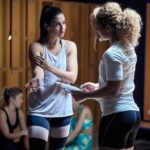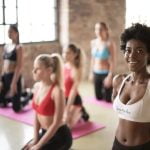Balancing exercise and school can be a daunting task for many students. With busy schedules, academic responsibilities, and extracurricular activities, finding time to stay physically active may seem nearly impossible. In this article, we will explore practical strategies on how to fit in exercise with school, offering advice on setting realistic goals, finding time in your schedule, utilizing school facilities, and prioritizing physical activity.
In today’s fast-paced world, it is increasingly important for students to incorporate regular exercise into their daily routines not only for physical health but also for mental well-being and academic success. However, many students struggle to find the time or motivation to prioritize physical activity amidst the demands of their studies.
This introductory section will address the common challenges faced by students in balancing exercise and school and provide an overview of the strategies that will be discussed in the following sections.
Throughout this article, we will delve into practical tips on setting achievable goals for exercise, making use of school facilities and resources, incorporating physical activity into your daily routine, maximizing break times for quick workouts, and planning and prioritizing physical activity. Additionally, we will highlight the benefits of exercising during the school years and offer guidance on overcoming common obstacles to staying active while pursuing education.
Whether you are a high school student or a college student, this article aims to help you navigate the challenge of fitting in exercise with your academic commitments.
Setting Realistic Goals for Exercise
Setting realistic fitness goals while balancing the demands of school can be challenging, but it is definitely possible with some planning and commitment. Here are some tips on how to set achievable exercise goals while managing your academic responsibilities:
- Start by assessing your current level of physical activity and setting specific, attainable goals for improvement. For example, aiming to engage in at least 30 minutes of moderate exercise three times a week could be a realistic starting point.
- Consider your schedule and what types of exercises you enjoy or have access to. If you have limited time, high-intensity interval training (HIIT) workouts or short bursts of activity throughout the day can be effective.
- Keep track of your progress and make adjustments as needed. This could involve gradually increasing the duration or intensity of your workouts, or incorporating new activities to avoid boredom and continue challenging yourself.
By taking these steps, you can develop a personalized fitness plan that fits into your school routine without causing undue stress or interference with academic commitments.
Remember, exercise should be a source of enjoyment and stress relief rather than an additional burden. With some creativity and dedication, it is possible to find a balance between staying active and excelling in school.
Finding Time in Your Schedule
Fitting exercise into a busy school schedule might seem like a daunting task, but with the right strategies, it is definitely achievable. Here are some tips on how to fit in exercise with school:
1. Prioritize your activities: Make a list of all your daily commitments, including classes, study time, and extracurricular activities. Identify any pockets of time where you can squeeze in a quick workout or physical activity.
2. Create a schedule: Once you have identified possible time slots for exercise, create a schedule that includes specific times for physical activity. Treat this time as non-negotiable just like you would with your other responsibilities.
3. Optimize your commute: If possible, consider walking or cycling to school instead of taking the bus or driving. This can be an effective way to incorporate exercise into your daily routine without needing to find extra time in your schedule.
By following these strategies, you can effectively prioritize and integrate exercise into your school routine without feeling overwhelmed or sacrificing other important commitments.
Remember that finding time for exercise doesn’t always mean setting aside hours at the gym. Sometimes, small changes in your daily routine can make a big difference in staying active and healthy throughout the school year.
Incorporating Physical Activity Into Your Daily Routine
Morning Workouts
One effective way to fit in exercise with school is to incorporate morning workouts into your routine. Waking up just 30 minutes earlier can allow you to squeeze in a quick workout before starting your day. Whether it’s a jog around the neighborhood, yoga in your living room, or a home workout video, getting some physical activity in the morning can set a positive tone for the rest of the day.
Active Transportation
Consider finding ways to incorporate physical activity into your mode of transportation to and from school. If possible, walking or biking to school can provide an excellent opportunity for exercise. If you rely on public transportation or a car, consider parking farther away from the entrance or getting off one stop earlier and walking the rest of the way.
Active Study Breaks
Instead of taking long study breaks that involve sitting down and scrolling through social media, use that time for physical activity. Whether it’s going for a short walk around campus, doing jumping jacks, or stretching, incorporating brief bursts of physical activity into your study breaks can help keep you energized and focused.
Incorporating physical activity into your daily routine may require some creativity and flexibility but by making it a priority and utilizing these strategies, you can find ways to stay active while managing the demands of school.
Making Use of School Facilities and Resources
Schools often offer a wide range of facilities and resources that can help students incorporate exercise into their daily routine. From gymnasiums to athletic fields, schools provide convenient access to spaces for physical activity. Many schools also have fitness centers or exercise equipment that students can use before, during, or after school hours. Taking advantage of these resources can make it easier for students to fit in exercise with their busy academic schedules.
In addition to physical facilities, schools may also offer organized sports teams, intramural leagues, or fitness classes. Joining a sports team or participating in a fitness class is an excellent way to stay active while connecting with peers who share similar interests. These activities may be scheduled at times that align with the school day, making it easier for students to participate without feeling overwhelmed by additional time commitments.
Furthermore, some schools integrate movement breaks into the academic schedule. This may include short periods of time during the school day dedicated to physical activity, such as recess, physical education classes, or walking breaks between classes. Students can utilize these designated opportunities to engage in quick workouts or simply move around to break up long periods of sitting.
| School Facilities | School Resources |
|---|---|
| Gymnasiums | Organized sports teams |
| Fitness centers | Intramural leagues |
| Athletic fields | Fitness classes |
Utilizing Break Times for Quick Workouts
Finding time to exercise while juggling school work and other commitments can be a challenging task for students. However, utilizing break times for quick workouts can be an effective way to incorporate physical activity into a busy school schedule. By making the most of short breaks between classes or study sessions, students can reap the benefits of exercise without compromising their academic responsibilities.
One way to fit in a quick workout during break times is by engaging in high-intensity interval training (HIIT) exercises. HIIT workouts are designed to be short yet intense, making them perfect for brief periods of free time.
These workouts can easily be done in a small space and require minimal equipment, making them ideal for school settings. Students can perform exercises such as jumping jacks, squats, lunges, and burpees to get their heart rate up and break a sweat in just a few minutes.
Another option for utilizing break times for quick workouts is to take advantage of outdoor spaces on campus. Whether it’s a brisk walk around the campus grounds or a jog around the track field, getting some fresh air and movement during breaks can help students rejuvenate their energy levels and refocus on their studies. Additionally, many schools have fitness stations or outdoor workout equipment that students can use during their free time.
Lastly, incorporating stretching or yoga into break times can help students relax and alleviate some of the stress that comes with academic demands. Simple yoga poses or stretching exercises can be performed in a quiet corner of the library or an empty classroom during breaks, providing not only physical benefits but also mental relaxation.
| Quick Workout Idea | Benefits |
|---|---|
| High-intensity interval training (HIIT) | Short yet intense workout that requires minimal time and equipment |
| Outdoor activities (walking, jogging) | Fresh air and movement helps rejuvenate energy levels |
| Stretching or yoga | Alleviates stress and provides mental relaxation |
Planning and Prioritizing Physical Activity
In the midst of balancing school work, extracurricular activities, and social commitments, it can be challenging to prioritize physical activity. However, with proper planning and prioritization, it is possible to fit exercise into your busy schedule. Here are some tips on how to make physical activity a priority in your daily routine.
Creating a Schedule
One way to ensure that you prioritize physical activity is by creating a schedule or calendar that includes designated time slots for exercise. Whether it’s before school, during lunch breaks, or after classes, blocking off specific times for physical activity can help make it a non-negotiable part of your day. By treating exercise as an important commitment, you are more likely to follow through and make time for it amidst other responsibilities.
Setting Specific Goals
Another way to prioritize physical activity is by setting specific goals for yourself. Whether it’s aiming to work out a certain number of times per week or training for a specific fitness milestone, having clear objectives can motivate you to prioritize exercise in your schedule. Additionally, setting goals can give you something tangible to work towards and provide a sense of accomplishment when achieved.
Prioritizing Self-Care
It’s important to recognize the importance of self-care and the role that physical activity plays in maintaining overall well-being. By acknowledging the benefits of exercise for mental health, stress relief, and overall energy levels, you may be more inclined to prioritize physical activity in your schedule. Making time for self-care can also improve your ability to focus on school work and other tasks, making it a crucial aspect of your overall success as a student.
By implementing these strategies and recognizing the importance of physical activity in maintaining overall well-being during school years, you can make exercise a priority in your daily routine despite a hectic schedule.
Benefits of Exercising During School Years
Exercising during school years offers numerous benefits that can positively impact both academic performance and overall well-being. One of the key advantages of incorporating physical activity into your daily routine is the boost it provides to cognitive function. Research has shown that regular exercise can improve concentration, memory, and problem-solving skills, making it easier to stay focused and alert in class.
Additionally, engaging in physical activity during school years can help reduce stress and anxiety. The demands of academic responsibilities can often lead to high levels of stress for students. However, regular exercise has been proven to release endorphins, which are natural stress-fighters, leading to improved mental health and overall mood. This is especially important during times of heightened pressure such as exams or deadlines.
Furthermore, developing healthy exercise habits during school can set a foundation for lifelong fitness and well-being. By creating a routine that incorporates physical activity alongside academic commitments, students can establish healthy lifestyle habits that will benefit them beyond their school years. These habits may include time management skills, goal setting, and prioritizing self-care – all of which contribute to overall success in various aspects of life.
By understanding and embracing the benefits of exercising during school years, students can prioritize their physical health along with their academic achievements. With dedication and commitment to integrating physical activity into their daily routines, students can experience enhanced cognitive function, reduced stress levels, and the establishment of lifelong healthy habits.
Overcoming Common Obstacles to Exercise in School
In conclusion, fitting exercise into a busy school schedule may seem daunting, but with the right approach and mindset, it is possible to prioritize physical activity alongside academic responsibilities. Setting realistic goals, finding time in your schedule, and incorporating physical activity into your daily routine are essential strategies for ensuring that exercise becomes a regular part of your life.
By making use of school facilities and resources, utilizing break times for quick workouts, and planning and prioritizing physical activity, students can overcome common obstacles to exercise in school.
It is important for students to recognize the benefits of exercising during their school years. Not only does regular physical activity contribute to overall health and well-being, but it also has positive effects on academic performance and cognitive function. By making exercise a priority, students can improve their concentration, reduce stress levels, and enhance their mood – all of which can lead to greater success in their academic pursuits.
While there may be challenges and obstacles along the way, it is possible for students to fit in exercise with school. With determination, motivation, and strategic planning, individuals can strike a balance between their studies and physical activity. By recognizing the importance of maintaining a healthy lifestyle during the school years, students can cultivate habits that will benefit them well beyond graduation.
Frequently Asked Questions
How Can I Workout When I Have School?
It can be challenging to find time to workout when you have school, but it’s definitely possible. One way is to schedule your workouts at times that don’t interfere with your class schedule, such as early in the morning or in the evening.
How Do You Balance School and Exercise?
Balancing school and exercise requires careful time management and prioritization. You may need to sacrifice some social activities or leisure time in order to fit in regular exercise, but it’s important for both your physical and mental well-being.
How Do You Stay in Shape at School?
Staying in shape at school involves incorporating physical activity into your daily routine. This can include walking or biking to campus, using the school gym or fitness facilities, participating in sports or recreational activities, and making healthy food choices to support your fitness goals.

Passionate about providing useful information to anyone with an interest in the field of Personal Training, I strive to pass on to our readers quality information and to answer any questions about Personal Trainers, the work they do and how to become one.





